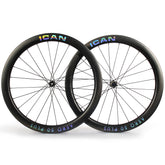Find the Perfect Fit: How to Choose Between Aerodynamic and Lightweight Wheels
Many road cyclists face a dilemma when upgrading their bike's wheelset. With so many options available on the market, it can be difficult to determine which type of wheel best suits your needs.
Broadly speaking, we can divide the options into lightweight or aero if you want to upgrade your wheels. You either want to reduce the weight of your bike or make it more aerodynamic.
It is important to note that not every wheel set can be placed into one category and that the distinctions between categories are often unclear. The emergence of medium-section rims, for example, offers riders an all-in-one solution that combines aero efficiency and light weight. Depending on your goals, you may want to opt for a wheelset that leans more towards one end of the spectrum or the other.
Should I go for aero or lightweight? That is the question here.
aerodynamic wheels
Rolling resistance and air resistance are the two factors that slow down cyclists on a flat road.
At low speeds, rolling resistance is the most important force affecting tire resistance. However, as speed increases, air resistance becomes the dominant force. With average road holding with good tires, you can expect a 50/50 split between tire and air resistance forces at a speed of 12.5 km/h.
Aerodynamics also play a crucial role at relatively low speeds. As speed increases, the proportion of effort required to overcome air resistance becomes significantly higher. For example, at a more realistic speed of 20 mph on a flat surface, about 75% of the effort is needed to overcome air resistance.
An aerodynamic rim with greater depth can help reduce drag caused by airflow for both the rider and the bike. Because air resistance is the primary force the rider must overcome, an aerodynamic wheelset can provide "free speed." Combined with other aerodynamic benefits, the argument for using an aerodynamic wheelset becomes even more compelling.

Lightweight wheels
When cycling uphill, weight becomes an important factor in determining the effort required. On a 10 percent incline, a 75 kg rider uses about 90% of his strength to overcome gravity.
To maintain a speed of 10 km/h on this incline, the 75 kg driver would have to use around 415 watts. For every kilogram of weight reduction, around five watts are saved.
When climbing, weight is more important than aerodynamics. However, if you are driving on flat roads, hilly terrain, or a mountainous route with long valley roads, aerodynamics may become more important. It is important that you consider the demands of cycling when choosing your wheelset.

Is the middle part an optimal compromise?
A medium depth rim provides a balance between weight, responsiveness, inertia and drag reduction.
For an average rider weighing around 75kg, a wheelset with a diameter of 45-55mm is considered perfect. It's light enough for a 75kg rider to climb, but low enough to feel the aerodynamic benefits.
Most riders on Team Dimension Data consider the Enve 4.5 (45/55mm) to be their main all-day wheel. However, on flat or hilly stages, some riders like Mark Cavendish prefer the deeper 7.8 (70/80mm) wheelset to take full advantage of its aerodynamic benefits. The Enve 3.4 (38/42mm) is only used by heavier riders on climbs.

alloy or carbon rims
Carbon road bike wheels will outperform any other wheel you use. As a long-time rider, I know how much bicycle components can affect a bike's performance. Two bike parts with the same price can differ significantly in performance. Carbon road bikes are the components you want on your bike. I will list the features that make carbon road bikes better and why you should choose them:
Weight: Carbon racing bikes are the lightest bikes, although newer technologies are trying to make aluminum bikes lighter. Carbon fiber is the lightest material used in the manufacture of bicycle components and serves the purpose of helping the bicycle maintain a constant speed.
Aerodynamics: Aerodynamics is one of the most important points to consider when cycling. Carbon wheels are particularly aerodynamic and help you maneuver air resistance and resistance pressure. They ensure that you reach higher speeds with less effort, regardless of the surface you are driving on.
Impact Absorption: Shock absorption is a very important factor for a smooth and comfortable ride and this is why you should choose carbon wheels. The shock absorption properties of a bicycle ensure that the rider does not feel the impact when landing at low altitudes, on uneven terrain, etc. Carbon fiber is the perfect material to absorb the impact of cycling.
Other features include efficiency, versatility and design. Carbon road bike wheels generally offer the best features you can expect from bicycle wheels, and there is little substitute for them.
The right bike for you
To choose the perfect wheel for your bike, you should consider your riding style. If you ride primarily uphill, a lightweight balance bike would be suitable. However, if you enjoy riding downhill or on flat terrain, a medium depth wheel would be ideal.
In general we recommend increasing the rim depth between 30 and 50mm as this provides significant aerodynamic benefits that outweigh the slightly increased weight. In addition, the wheels are more stable with this configuration.





